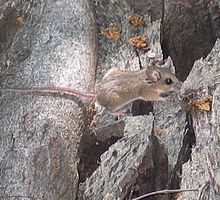
Brush mouse

The brush mouse (Peromyscus boylii) is a species of rodent in the family Cricetidae. It is found in mountainous areas of Mexico and the western United States at altitudes over 2,000 m (6,600 ft). The brush mouse is medium-sized, with small ears and a long tail. It has yellowish-brown fur on the body, with slate grey under parts. The tail has only sparse hair for most of its length, but with a distinct brush-like tuft of hair at the tip (although the common name is, perhaps, more likely to come from brushy environment in which it lives). It has a head-body length of 86 to 105 mm (3.4 to 4.1 in) with a tail 88 to 115 mm (3.5 to 4.5 in) long. It is very similar in appearance to a number of closely related species of mouse living in the same area, although it can be distinguished from them by such features as the length of its tail, the size of its ears, and the presence of the tuft on the end of the tail. The brush mouse can be found from northern California to eastern Colorado and western Texas, and south to Baja California and southern Mexico. Fossils of brush mice up to 35,000 years old have been discovered, but none have been definitively identified from outside the current range of the species. Vegetation in brush mouse habitats may vary from location to location, but brush mice are consistently captured in areas with medium to high densities of shrubs and tree cover under 16 ft (4.9 m) in height. In California, mature chaparral (cover ≥50%) appears to provide more suitable habitat for brush mice than young, open chaparral (cover <50%). Similarly, in Arizona, Duran captured brush mice most frequently in shrub live oak and birchleaf mountain-mahogany (Cercocarpus betuloides) understory habitats with 45% to 50% plant cover. Fewer brush mice were captured in habitats with less plant cover. Holbrook observed that after vegetation crowns were removed in a manzanita (Arctostaphylos spp.)-oak shrubland, brush mice avoided the newly opened space. In another study, brush mice were strongly restricted to habitats in which gaps between rocks or ceanothus (Ceanothus spp.) on the site were less than 4 ft (1.2 m). In addition to shrub density, the height of cover appears to influence brush mouse distribution within a site. An average understory height of 5.0–6.5 feet (1.5–2.0 metres) was preferred by brush mice over lower understory cover. In another study, brush mouse presence was positively correlated with microhabitats of shrub cover up to 10 feet (3.0 m) tall, logs over 3 inches (7.6 cm) in diameter, and understory trees 10–33 feet (3.0–10.1 metres) in height, but negatively correlated with grass-forb microhabitats. Brush mice are also commonly captured at locations with high proportions of rock cover and/or slash piles in habitats characterized by chaparral-mountain shrub, oak/shrub, oak-juniper-pinyon pine, juniper-pinyon pine, and oak-pine communities, as well as riparian habitats. The brush mouse in Texas has been found in all major habitats present (desert, grassland, riparian, and montane), although it is typically associated with rock outcrops within these habitats. Riparian sites with abundant brush mouse populations had high shrub cover, high frequency of debris piles with low grass, litter, and tree cover. In a Mexico study, a canyon was dominated by exposed rock, grasses, pines, hardwoods, and brush. In West Texas, brush mice favored fallen logs and brush piles. Modi discovered that brush mice were common in riparian zones dominated by pecan (Carya illinoensis), American sycamore (Platanus occidentalis) and live oak (Quercus virginiana), in an oak community with a partially open canopy and dense understory, and in a pine forest with little understory and scattered boulders. In New Mexico, brush mouse populations were significantly (P<0.05) higher on sites that were bulldozed or thinned (98 and 115 captures, respectively) than untreated or bulldozed and burned sites. Populations were lowest on sites that had not been treated (45 captures). Sites that had increased slash from bulldozing and burning had more brush mice (57 captures) than the untreated sites, but the difference was not significant (P>0.05). No influence of canopy cover on brush mice was observed by Severson et al. Besides high tree, shrub, and rock densities, brush mice appear to prefer locations with low grass cover. At the same time, grasses are often present in the understory indicating that grasses do not exclude brush mice. Brush mice used grazed and ungrazed pastures and ceanothus plots, but they were concentrated around rocky outcrops and vegetation continuous with the rock outcrops. No brush mice were captured in the grasslands more than 20 ft (6.1 m) from rocks, shrubs, or trees. Litter depth also appears negatively correlated to brush mouse presence. For instance, brush mice in Arizona were captured in litter depths of only 0.9 inches (2.3 cm). Brush mice also use fire-affected habitats. In one study, brush mice were captured in burned and unburned chaparral, as well as burned and unburned pine-oak forest. The highest number of captures were recorded in unburned forest, while the lowest captures occurred in the unburned chaparral. These results are somewhat inconsistent with other observations which show the brush mouse favoring dense chaparral habitat. Small mammal capture data in the study were collected from 14 months to three years after fire. The time frame of sampling after fire may influence the perceived response of the brush mouse to burned habitats.
